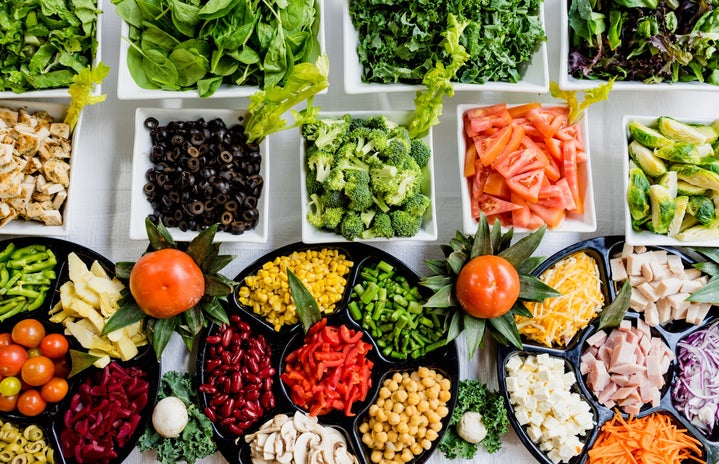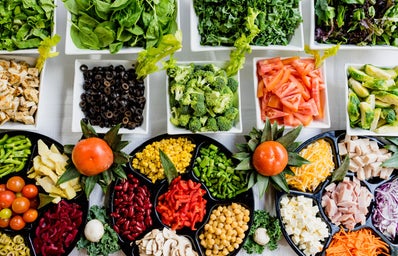Endless buffets, all-you-can-eat dessert bars and trays of greasy fries and burgers tend to pop into mind when you think of college cafeterias. However, many colleges are moving towards healthier and more delicious options for their students! Which schools take the cake (not literally) for healthy dining? Read on for a look at the organic, all-natural, vegetarian, vegan and downright diet-friendly worlds of the nation’s ten healthiest dining halls.
1. Bowdoin College: Brunswick, ME
Students at Bowdoin enjoy the fact that their dining hall has been ranked by Collegeprowler.com as #1 in the nation. However, the dining hall’s food doesn’t just taste good, it’s also healthy! The dining hall staff purchases most of its food from local sources, and much of the produce comes from the college’s own organic garden. Students have access to fresh and healthy entrees like steamed zucchini, southwestern black bean and couscous salad, and a make-your-own sauté station. Daisy Alioto, a Bowdoin collegiette™, especially loves Bowdoin’s healthy flatbread. “They make it with bleu cheese, onions, and apple, which may sound gross but it’s amazing!”she says. She also enjoys Bowdoin’s international food options and healthy soups.
2. Stephen F. Austin State University: Nacogdoches, TX
At Stephen F. Austin State University, students enjoy water flavored with fresh fruits, vegetables and herbs at the university’s “Hydration Station”. SFA also makes it easy to pick healthy meals in the cafeteria – the above logo is featured on meals chosen by the school’s own registered dietitian, and students can even follow the dietitian on twitter for more advice on how to stay healthy and strong. According to Jessika Davidson, an SFA collegiette™, her university provides food for the fitness enthusiast in everyone. “My favorite healthy meal is the tofu stir-fry from the East College Cafeteria on campus,” she says. “Pair that with the cucumber or lemon flavored water and enjoy a great meal!”
3. Oberlin College & Conservatory: Oberlin, OH
Oberlin College may be small, but their dining hall options are not! Oberlin students use an exhibition bar to select the healthy ingredients used for their pasta dishes, stir-fries, fajitas, pierogies and wraps. There is also a year-round fruit bar in their main dining hall, and a huge selection of vegetables at every meal. In Dascomb food court, a freshman dorm dining hall, students enjoy a special station for vegetarian comfort foods (think eggplant parm), an extensive salad bar and a grill with sandwiches made with antibiotic-free chicken. And apart from a variety of healthy meal options, Oberlin also achieved an A on the College Sustainability Report Card, meaning that they make a concerted effort to reduce their environmental footprint and use primarily locally grown produce.Sarah MacFadden, an Oberlin freshman, appreciates that most of the food produced in her dining hall is locally grown and harvested. “Not only does that make it healthier, but that also makes it more environmentally sustainable,” she says. “My favorite meal is at the station called “Global Exhibitions” where each day they prepare different kinds of healthy stir fry in front of you- it’s delicious!”
4. St. Olaf College: Northfield, MN
The students at St. Olaf knew that their college’s food would be good when they decided to attend – it’s been ranked in the top ten in the nation by multiple websites including CollegeProwler. But this college’s food doesn’t just taste good – it’s also healthy. Dining Services receives most of their produce from STOGROW, a student-run organic farm located near campus. They also get their dairy products from Deja Moo, a family-owned dairy company. St Olaf’s cafeteria boasts eight lines of food, plus an extensive salad bar, soups, cereal and desserts. Vegetarian and vegan students enjoy their own line, which features things like couscous, falafel and organic grains. The daily dinner menu includes delicacies like red wine-braised beef, parmesan risotto, truffle green beans, albondigas with chipotle-tomato sauce, chicken pad thai and garlic black bean tofu. Hungry yet? Their cafeteria is also 100% sustainable, so it produces healthy food without hurting the environment!
5. Lewis & Clark College: Portland, OR
Lewis and Clark College’s dining services makes it their mission to create food that is alive with flavor and nutrition, and it seems that the college has achieved its goal. All ingredients from the Lewis and Clark kitchen are organic and natural, and the university’s Sustainability Council helps the dining hall focus on leaving a minimal environmental footprint. Students choose from daily entrees like 10-grain cereal, organic tofu scrambles, frisee salad sandwiches (with house-made honey-cured lardon, poached eggs and sherry vinaigrette served with toasted brie on a baguette) and ginger soy miso soup with arugula.
[pagebreak]
6. Bates College: Lewiston, ME
At Bates College, students have free access to a nutritional consultant, who also helps dining services plan the menus each week. Menu identification cards with dietary information can be found next to each entrée. Bates also uses all low-fat and non-fat options, and they contract with local farmers to provide the freshest produce possible. Students love the pasta station, the vegan station, the brick oven and the euro station (where students can taste low-fat versions of European foods each day). They also enjoy favorite entrees like whole wheat spaghetti, miso vegetable soup with tofu and pork loin roasted with fennel and rosemary.
7. Pitzer College: Claremont, CA
Pitzer College, one of the five Claremont colleges, believes that a healthy environment, community and menu are all vital to the well-being of their students. Their dining hall revolves around a “Farm to Fork” program, which features organic vegetables, nuts, grains and fruits which are purchased from local farms and combined to create vegetarian and vegan entrees, sandwiches, juices and side dishes. Pitzer students enjoy a salad bar with fresh greens and homemade dressings, a smoothie bar, an omelet bar and a corner deli with meats, cheeses and roasted vegetables.
8. UC Berkeley: Berkeley, CA
In 2006, UC Berkeley became the first certified organic kitchen at an American university. Since then, the university has continued to build their reputation for sustainable, healthy food. All four dining halls managed by Cal Dining have extensive salad bars loaded up with only organic delicacies, and they also use trans-fat-free food products and feature healthy meat choices like turkey bacon and chicken-apple sausage. Aleyni Cerezo, a Berkeley sophomore, maintains that her university is one of the best in the nation when it comes to healthy eating. “Berkeley’s food facilities are the best because of their effort to provide healthy meals at a minimal cost to the environment,” she says. “I love Crossroads for its international flavors and its variety of food, as well as its consistent provisions of healthy pizza, salad, sandwiches, and organic food.”
9. University of Washington: Seattle, WA
The University of Washington is located in a city which prides itself on organic and healthy eating, so it’s no surprise that the dining staff at the University of Washington is masterful at creating healthy meal options for their students despite the university’s large size. A dietitian consults with dining services each week to make menus, and all meats are baked or grilled, not fried. Veggies are always steamed and the fried ingredients of every “grill” meal can be substituted with fresh ingredients upon request.
10. Humboldt State University: Arcata, CA
At Humboldt State University, students rave about the smoothie bar and the extensive salad bar, which features a variety of fresh vegetables, fruits and pre-prepared salads. The main dining room on campus offers three entrees per meal, one of which is always vegetarian, and a make-your-own sandwich bar during lunch, which is stocked with organic options from the university’s own student-run garden. Humboldt has a special program called “The Green Scene”, which helps the university focus on being environmentally friendly, and students involved in WRRAP (Waste Reduction and Resource Awareness Program) work to create renewable energy and to compost leftover dining hall food.
From hydration stations to make-your-own smoothie stations, these universities work hard to promote healthy, happy lives for their students. Do you think your university’s dining hall belongs on this list? Tell us about it!
Sources:
Collegiettes from across the country
http://www.bowdoin.edu/sustainability/dining/healthy-food.shtml
http://new.oberlin.edu/student-life/dining/dining-halls/http://www.pitzer.edu/student_life/dining_hall.asp
http://www.bates.edu/dining/who-we-are/food-quality-and-nutrition/
http://www.hfs.washington.edu/dining/residential/
http://www.campusdish.com/en-US/CSSW/StephenFAustin/Nutrition/
http://collegeprowler.com/st.-olaf-college/campus-dining/#ixzz1dGXmCKXV
http://www.stolaf.edu/admissions/campus/dining.html
http://www.minnpost.com/learningcurve/2011/09/07/31373/from_parmesan_ris…
http://www.humboldt.edu/housing/dining/locations/thej.html
http://berkeley.edu/news/media/releases/2006/04/03_organic.shtml
http://www.cafebonappetit.com/menu/your-cafe/lewisandclark/cafes/details/150/fields-dining-room
http://www.insurancequotes.com/healthiest-colleges-and-universities/
http://collegeprowler.com/rankings/campus-dining/#ixzz1VOlapeYU

